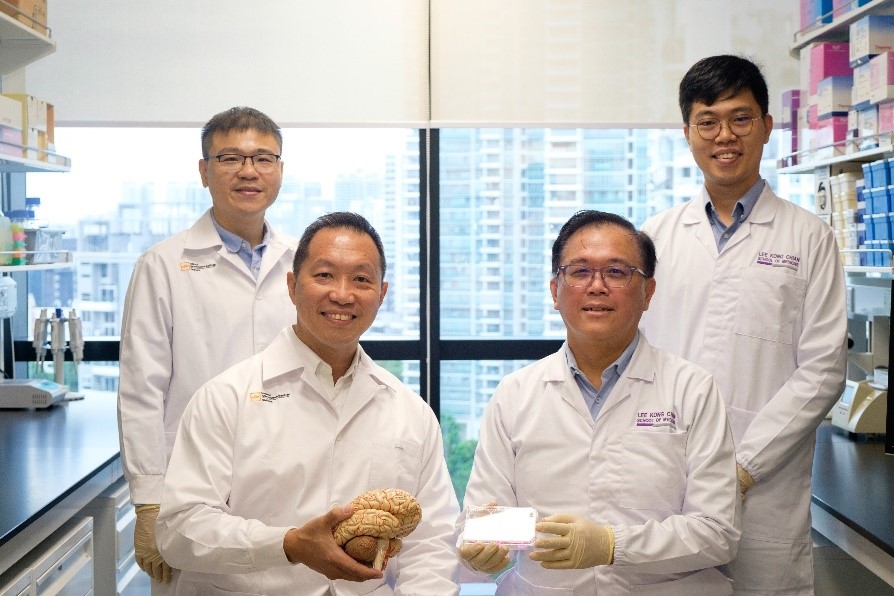Research: LKCMedicine Researchers Repurpose Existing Cancer Drugs To Treat Brain Cancer
 | By Sanjay Devaraja, Editor, LKCMedicine's Redefine Newsletter |

Glioblastoma is a frequently fatal form of brain cancer, with only five percent of patients surviving more than five years. This cancer is challenging to treat and almost always develops resistance to therapies, making recurrence nearly inevitable.
However, a new study conducted by researchers from LKCMedicine and the National Neuroscience Institute (NNI) offers renewed hope for glioblastoma patients. Their research could lead to more targeted and effective treatments, potentially preventing the recurrence of the disease.
Currently, the chemotherapy drug temozolomide (TMZ) is used to treat glioblastoma. TMZ works by damaging the DNA of cancer cells, preventing them from dividing. Despite this, glioblastoma often returns, as the cancer eventually develops resistance to the drug. This resistance is driven by the tumour's genetic heterogeneity, where different cell populations within the tumour have varying properties, making it more likely that some cells will resist treatment.
In addition, treatment options for drug-resistant glioblastoma are limited, as few drugs can pass through the blood-brain barrier, a protective membrane regulating substance entry into the brain.
To explore the mechanisms behind drug resistance and identify potential targets for treating resistant glioblastoma, LKCMedicine researchers examined protein kinase activity in two types of glioblastoma cells: mesenchymal glioblastoma (ME) and proneural glioblastoma (PN). Protein kinases are enzymes that play a role in cancer growth and spread through cellular signaling pathways.
ME is the most aggressive and treatment-resistant form of glioblastoma, while PN patients tend to have better outcomes. However, during treatment, PN glioblastoma can transform into ME, leading to cancer relapse.
The researchers discovered that in ME cells, mitogen-activated protein kinases (MAPKs) were more active compared to PN cells, particularly p38MAPK and MEK/ERK. In ME cells, p38MAPK promotes the activity of drug transporter proteins that remove drugs from cells and enhances the ability of glioblastoma cells to repair the DNA damage caused by TMZ. These factors contribute to ME's resistance to treatment.
Meanwhile, MEK/ERK signaling becomes active as glioblastoma cells develop adaptive resistance after drug treatment. When p38MAPK is inhibited, the intracellular pH drops, calcium levels rise, and MEK/ERK signaling is triggered, boosting the survival of glioblastoma cells. This drop in pH also reduces TMZ’s conversion to its active form, weakening its effectiveness.
To test potential treatments, researchers implanted ME cells into mice. Mice treated with a combination of the p38MAPK inhibitor ralimetinib, the MEK inhibitor binimetinib, and TMZ had a median survival of 72.5 days, compared to 63 days for mice treated with TMZ alone.
Assoc Prof Andrew Tan of LKCMedicine, who co-led the research, said “Our study has shown that glioblastoma acquires drug resistance through multiple pathways, highlighting the need for more precise treatments of the disease.”
“Instead of using a single drug, therapies that target the innate and adaptive mechanisms of drug resistance simultaneously could be feasible treatments for resistant glioblastoma tumours,” said Dean’s Postdoctoral Fellow at LKCMedicine Dr Hong Sheng Cheng, who is the first author of the study.
"We have demonstrated that the repurposing of existing drugs is a key strategy to maximise the implementation of precision medicine in cancer, especially when treating highly recurrent tumours like glioblastoma,” said Assoc Prof Ang Beng Ti, senior consultant at the Department of Neurosurgery and co-Principal Investigator at the Neuro-Oncology Lab in NNI, one of the co-lead investigators.
The researchers aim to carry out clinical trials to move the treatment closer to practical application. They also plan to utilise advanced molecular profiling methods in conjunction with artificial intelligence technologies, including machine learning, to optimise the strategic combination and administration of drugs for glioblastoma treatment.

